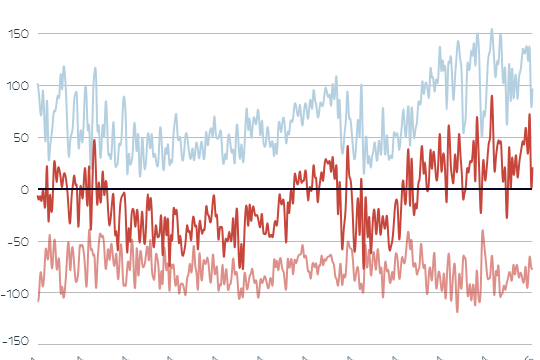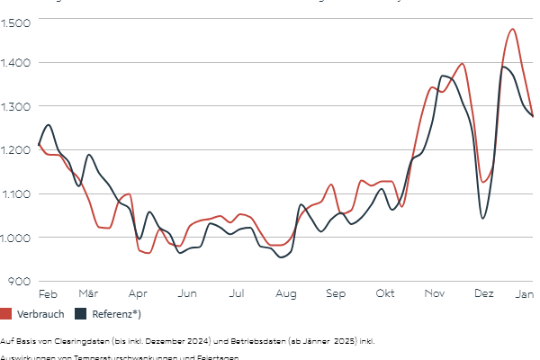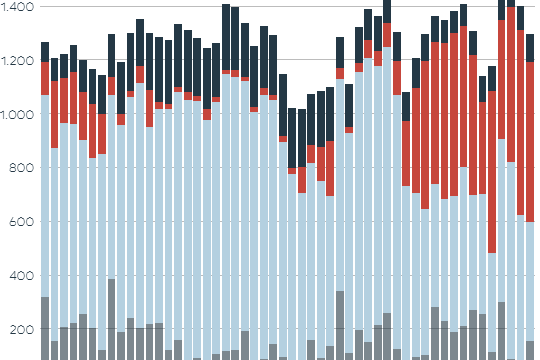In January, Austria (APG control area*) was able to export electricity only on a single day, while on balance, imports totaled 963 GWh (based on the schedules). The main reason for this development is the lower generation of renewables. In comparison, Austria exported electricity on 20 days in January 2024, resulting in a net export of 310 GWh (based on the schedules).
Decline in renewables production
Extremely dry weather conditions, no wind and a lack of sunshine led to a significant drop of 30 percent in the feed-in of renewable energy in January (calendar weeks 1-5) compared to the previous year. The share of renewable energies (3,885 GWh) in the total feed-in (5,868 GWh) was around 66 percent.
At 2,697 GWh, hydropower - which was reduced due to seasonal factors - accounted for around 69 percent and thus contributed the largest share of renewable energy in January; compared to the previous year, this was one percent less. Wind energy contributed 734 GWh to the production of sustainable electricity (minus 5 percent in the share of renewables compared to January 2024), while the PV feed-in amounted to 213 GWh (plus 3 percent).
Gas-fired power plants still required as a secure grid reserve
In January - a month with low renewable generation and high electricity consumption - thermal power plants were indispensable to secure the domestic electricity supply. In addition to these thermal capacities, extensive electricity imports were necessary to cover the demand in Austria.
This illustrates once again how essential gas-fired power plants are for a secure electricity supply in light of the delayed expansion of the transmission grid. "In periods of high consumption combined with low renewable generation, it is always necessary to start up gas-fired power plants to secure the domestic power supply. With a high-capacity electricity grid and good national and international connections, such periods could be better compensated for, also by importing renewables from abroad. Forgoing a secure grid reserve is unthinkable at the moment, given the delayed expansion of the transmission grid," says Gerhard Christiner, APG’s CTO.
No energy transition without a strong electricity grid
A strong grid is necessary to make the volatile, renewable electricity in Europe available on a national level and to transport it to where it is needed. To avoid grid overloads and ensure a secure supply, the electricity flow is managed with so-called redispatch measures, i.e. the targeted use of controllable power plants.
In January 2025, interventions in the schedule of power plants in Austria were necessary on 21 days to avoid overloads of the grid. This is 6 days more than in January 2024. These interventions cause costs that eventually have to be borne by the electricity customers. In January 2025, these costs totaled approx. 4.3 million euros. These costs reflect the lack of grid capacities.
A negative effect in addition to the costs and rising CO2 consumption is the "curtailment" of renewable power plant production: For example, wind power plants or run-of-river power plants that would be producing electricity at a certain time are shut down to avoid overloads in the electricity grid. Since the beginning of the year, around 900 MWh of electricity has been "lost" due to these measures and redispatching.
These figures underline the need for a modern and resilient energy industry system with a high-capacity transmission grid infrastructure.
Energy exchange within Austria
The exchange of energy across Austria is managed via APG’s electricity grid. Electricity surpluses in individual provinces can thus be distributed throughout Austria to compensate for deficits.
In January, Vorarlberg (170 GWh) and Carinthia (162 GWh) fed the highest volumes of energy into the APG grid and thus made it available throughout Austria. Lower Austria (281 GWh) and Carinthia (221 GWh) drew the most electricity from the APG grid.
Responsible energy consumption
The available data show that 6,695 GWh of electricity were consumed from the public grid in Austria in January (calendar weeks 1-5) - around 3.1 percent more than in January 2024 (6,494 GWh). This is the electricity drawn from the public grid in the APG control area. The figures do not include electricity produced and consumed by private PV units.
It is important to act responsibly when it comes to electricity consumption. Saving electricity reduces CO2 and overall systemic costs, which are significant contributions to increasing system security. The trend of reducing CO2 has to be pushed further. This also includes electricity from private PV units.
Tips for saving electricity can be found at www.apg.at/stromspartipps. With the APG Powermonitor, the Austrian population can see the most effective electricity-saving hours and thus make an active contribution to CO2 reduction and system security. The APG Powermonitor can be found at: www.apg.at/powermonitor.
APG continually keeps track of the development of the domestic electricity industry and regularly publishes diagrams at https://www.apg.at/infografiken regarding the topics: energy exchange, energy consumption in Austria, renewables production, import/export, electricity prices, etc.
* The APG control area comprises almost all of Austria with the exception of a corridor each in Vorarlberg and Tyrol.
Click here for the current infographics
About Austrian Power Grid (APG)
As independent transmission system operator Austrian Power Grid (APG) is in charge of ensuring the security of the electricity supply in Austria. With our high-performance and digital electricity infrastructure and the use of state-of-the-art technologies we integrate renewable energies and reduce the dependency on electricity imports, we are the platform for the electricity market, and we provide access to reasonably priced electricity and thus create the basis for Austria as supply-secure and future-oriented industrial and business location and place to live. The APG grid totals a length of about 3,500 km and is operated, maintained, and continuously adapted to the increasing challenges of the electrification of businesses, industry, and society by a team of approximately 1,000 specialists. 67 substations are distributed all over Austria and the majority is operated remotely. Thanks to our committed employees Austria had a security of supply of 99.99 percent also in 2024 and thus ranks among the top countries worldwide. Our investments of 640 million euros in 2025 (2024: 440 million euros, 2023: 490 million euros) are a motor for the Austrian economy and a crucial factor for a secure energy transition.
Press contact
Christoph Schuh



